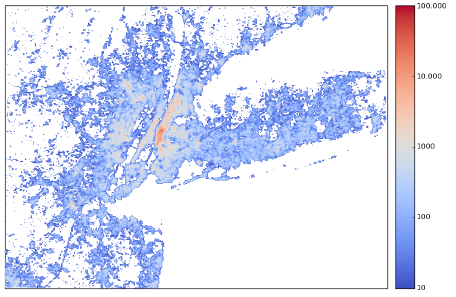Twitter Firehose Reveals How New York City Sleeps 3 Hours Later on Sundays
In the theme song from the film “New York, New York”, Liza Minnelli famously describes New York city as the city that never sleeps. Now data from the Twitter firehose shows how.

Urbano Franca and pals from the New England Complex Systems Institute in Cambridge collected geolocated tweets from the region around the city during every hour between August and December 2013. They then divided the region into 90,000 cells and counted the number of tweets produced in each cell. Finally, they compared the hourly activity in each cell against its weekly average.
The results provide a fascinating insight into the social heartbeat of the city. Franca and co say the data clearly shows New Yorker’s sleep cycles, their urban commutes and areas of particularly high activity, such as airports on Friday evenings.
The weekday activity cycle is particularly clear, reflecting periods when people have more time to tweet. Early in the morning, people tend to tweet from their homes in the suburbs, this activity switches to Manhattan after the morning commute and peaks there at lunchtime. The suburban activity rises again in the evening until about 10pm and begins to decrease as people go to bed. The activity in Manhattan continues throughout the night while the rest of the city sleeps.
Interestingly, the weekend sleep cycle is shifted by about three hours. There is significantly more activity on Saturday night/early Sunday morning which is distributed throughout the city’s urban centres. The morning activity peak then occurs at around 10am, some three hours later than usual.
Sunday afternoons show a unique pattern of activity that is widely distributed across residential communities and in some specific locations too, such as at the Statue of Liberty. “A peak of activity is observed in Central Park most of the day Sunday that is not observed on other days of the week,” say Franca and co.
Curiously, the data also shows how individuals with particularly high tweeting rates can dominate activity in their local areas too.
The team has produced a video of the results showing the ebb and flow of tweets in New York City and its bedroom communities throughout the week.
That’s an interesting use of twitter data to reveal the social dynamics of one of the world’s great cities. This kind of visualisation has the potential to help city planners better understand their charges.
For the first time, these planners have a “social microscope” that shows the interaction between city dwellers and the environment in which they live in detail. Beyond modifying the words to theme songs, exactly how they should use this insight isn’t yet clear; suggestions in the comments section please.
Ref: arxiv.org/abs/1411.0722 : Visualizing The “Heartbeat” Of A City With Tweets
Keep Reading
Most Popular
Large language models can do jaw-dropping things. But nobody knows exactly why.
And that's a problem. Figuring it out is one of the biggest scientific puzzles of our time and a crucial step towards controlling more powerful future models.
The problem with plug-in hybrids? Their drivers.
Plug-in hybrids are often sold as a transition to EVs, but new data from Europe shows we’re still underestimating the emissions they produce.
Google DeepMind’s new generative model makes Super Mario–like games from scratch
Genie learns how to control games by watching hours and hours of video. It could help train next-gen robots too.
How scientists traced a mysterious covid case back to six toilets
When wastewater surveillance turns into a hunt for a single infected individual, the ethics get tricky.
Stay connected
Get the latest updates from
MIT Technology Review
Discover special offers, top stories, upcoming events, and more.